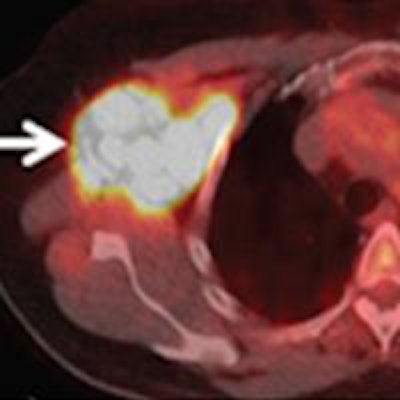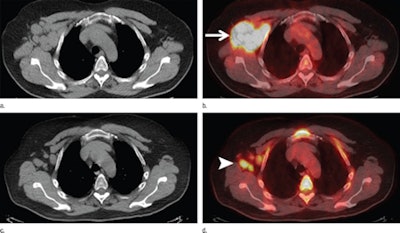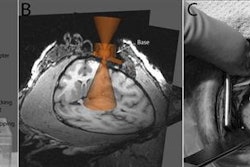
The presence of lesions on FDG-PET/CT scans prior to stem cell transplantation can help predict survival for patients with aggressive lymphomas, according to a study published in the November issue of Radiology.
Lymphoma patients who received stem cells donated from another person (known as allogeneic stem cell transplantation) were twice as like to survive after two years if they didn't have FDG-avid lesions on their PET scans, compared with patients with PET-positive results.
Among patients who were given their own stem cells (autologous stem cell transplantation), the presence of FDG-avid lesions prior to the procedure was associated with two-year progression-free survival of less than 20% -- one-fourth the survival rate of patients with negative PET results (Radiology, November 2015, Vol. 277:2, pp. 518-526).
"It was very striking that the presence of FDG-avid lymphoma prior to a stem cell transplant was an incredibly strong predictor of poor outcome following the transplant," lead author Dr. Gary Ulaner, PhD, an assistant attending radiologist at Memorial Sloan Kettering Cancer Center, told AuntMinnie.com.
The findings suggest that before clinicians opt for the "incredibly expensive and morbid procedure of stem cell transplantation, they should attempt with multiple rounds of chemotherapy to bring patients to a state where they have no FDG-avid lymphoma prior to transplant," he said. "That provides the best chance for transplant success."
Procedure volume
It's estimated that more than 45,000 stem cell transplant procedures are performed annually in the U.S. It is generally considered the most viable option when several rounds of chemotherapy are unsuccessful in arresting a patient's aggressive lymphoma.
FDG-PET/CT has been the modality of choice to evaluate chemotherapy treatment response and to assess the patient's condition before stem cell transplantation, which often produces good outcomes.
 Dr. Gary Ulaner from Memorial Sloan Kettering Cancer Center.
Dr. Gary Ulaner from Memorial Sloan Kettering Cancer Center.Past research has also indicated that patients with FDG-avid disease before autologous stem cell transplantation are likely to have less favorable results than individuals with no PET-positive lesions. However, previous studies have not explored the prognostic value of FDG-PET/CT before allogeneic and autologous stem cell transplantation in this patient population.
After applying exclusion criteria, Ulaner and colleagues retrospectively evaluated 73 patients who received an allogeneic stem cell transplant and 102 individuals who had an autologous stem cell transplant. Median age was 37 years (range, 18-70 years) for women and 48 years (range, 9-73 years) for men.
PET/CT scans were performed from midskull to upper thigh approximately 60 minutes after intravenous administration of 12 mCi to 15 mCi of FDG. All imaging exams occurred within the three months before stem cell transplantation at Memorial Sloan Kettering, between January 2005 and December 2010.
Ulaner, who was blinded to the results, analyzed the original FDG-PET/CT images, taking note of suspicious FDG-avid lesions and the maximum standardized uptake value (SUVmax) of the most avid lesion.
The researchers considered patients with suspicious FDG-avid lesions to be PET-positive and have an active malignancy, while non-FDG-avid lesions were considered a PET-negative result.
Ulaner and colleagues defined progression-free survival as the time between transplantation and first progression, death, or the last follow-up evaluation. Disease-specific survival was the interval between transplantation and the date of death from the disease or the date of the last follow-up examination. Overall survival was the time between transplantation and the date of death or the date of the last follow-up examination.
Survival rates
Among the 73 subjects in the allogeneic group, 23 had FDG-avid lesions and 50 had PET-negative results. Of the 102 autologous stem cell transplant patients, 11 had FDG-avid lesions and 91 had PET-negative results.
| 2-year survival rates for stem cell transplant patients | ||
| Survival | PET positive | PET negative |
| Allogeneic patients | ||
| Progression free | 35% | 68% |
| Disease specific | 65% | 91% |
| Overall | 65% | 84% |
| Autologous patients | ||
| Progression free | 18% | 72% |
| Disease specific | 45% | 90% |
| Overall | 45% | 90% |
Among the 23 PET-positive subjects in the allogeneic group, each unit increase in SUVmax increased the risk of disease progression by 13%. Meanwhile, for the 11 PET-positive subjects in the autologous group, each unit increase in SUVmax increased the risk of disease progression by 51%.
 A 54-year-old man with follicular lymphoma was classified as having PET-positive results before undergoing an autologous stem cell transplant. Axial CT (a) and FDG-PET/CT (b) images before chemotherapy show lymphomatous right axillary lymph nodes (SUVmax, 15) (arrow in b). Axial CT (c) and FDG-PET/CT (d) images after chemotherapy and before stem cell transplantation show that lymph nodes (arrowhead in d) decreased in size and are FDG-avid (SUVmax, 7). Images courtesy of Radiology.
A 54-year-old man with follicular lymphoma was classified as having PET-positive results before undergoing an autologous stem cell transplant. Axial CT (a) and FDG-PET/CT (b) images before chemotherapy show lymphomatous right axillary lymph nodes (SUVmax, 15) (arrow in b). Axial CT (c) and FDG-PET/CT (d) images after chemotherapy and before stem cell transplantation show that lymph nodes (arrowhead in d) decreased in size and are FDG-avid (SUVmax, 7). Images courtesy of Radiology.Clinical practice
The findings shine new light on potential outcomes with allogeneic and autologous stem cell transplants, Ulaner said. The greater the FDG avidity of the disease before the transplant, the shorter the time to relapse or the worse the outcome.
"The higher the FDG avidity, the worse they did," he said.
At Memorial Sloan Kettering, clinicians take FDG-PET/CT results to heart before proceeding to a stem cell transplant for aggressive lymphoma patients.
"Our clinicians currently do not transplant or very rarely transplant when FDG-avid disease is seen on FDG-PET/CT scans," Ulaner said. "They are using this [result] as a guide for when patients are ready for the stem cell transplant."




















